Trace and Cut
We'll be starting with the tutorial for Elan 645. Elan 645 has a full band, so much of what will be covered in the tutorial can apply to any similar pattern with a full band. The sample shown in this tutorial will be a 32A, probably cut down a bit when we get to the fitting process. My daughter needs new bras, I need samples for tutorials and you need a tutorial - we all win!
Once you have your pattern and have found your size - remember that I emailed you regarding wire size, which is the same as the pattern size - you'll need to find the correct sized pattern pieces. They are grouped by band size. For this pattern there are two options: one, a partially stretch band and stretch cups and two, a band that is stretch only in the back with non-stretch cups. Which option you chose will decide which pattern pieces you'll need for the band. For this tutorial, I am making the stretch cup version.
You will need to trace off the pattern pieces - do not cut them out of the tissue! You or whoever you are making this for may change in size and you might need those other sizes some day. The seam allowances are already included in the pattern pieces (hallelujah!), so all you have to do is trace. I just trace onto white tissue paper, the kind you'd use in gifts and gift bags. It is very easy to get and cheap. Make sure you mark all the dots, notches, direction of greatest stretch, and note the pattern number and size.
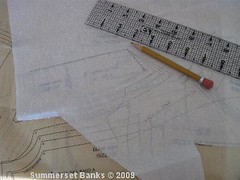
Once you have your pattern pieces, you can then cut out the fabric. To cut out the pieces, first check the pattern pieces for the greatest direction of stretch - this is similar to a grain line in a woven. Similarly, strange things happen if you don't follow the correct line - things will stretch that you don't want to stretch and stretchy parts won't stretch at all!
Now, find the direction of greatest stretch on the tricot. The tricot is a one way stretch fabric, meaning that it will stretch in one direction but not in the other. The power net is a 4 way stretch, meaning that it stretches in practically any direction. In the first photo, the fabric stretches in the horizontal direction, but not in the vertical as you see in the second photo.
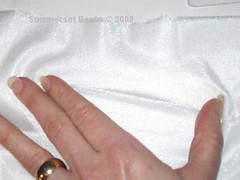
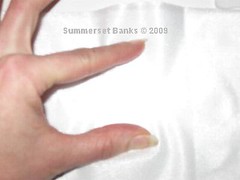 Following the direction of greatest stretch or grain lines on the pattern pieces, pin and cut. You may prefer to rotary cut the pieces, that's fine. I actually prefer to use scissors - all the time, except for rectangular piece which are easier to cut with a rotary cutter. You'll rarely see those in this type of sewing anyway.
Following the direction of greatest stretch or grain lines on the pattern pieces, pin and cut. You may prefer to rotary cut the pieces, that's fine. I actually prefer to use scissors - all the time, except for rectangular piece which are easier to cut with a rotary cutter. You'll rarely see those in this type of sewing anyway.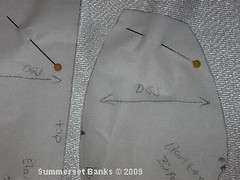
You can use the power net for the back bands, as you've probably seen in RTW. You can use it layered with the tricot for back bands and lower cups, and you can use it under lace for a little more stability. If you're making a smaller size, you might not need as much structure, but it can be a good idea for the larger sizes. Take a look at RTW, just to get an idea of what fabric they are using in what places.
As a general rule, I cut two of the upper cups of the lace and the two of either powernet or tricot depending on the strength of the lace and whether I want a little sheerness. I cut 4 of the lower cup, and I'll show you how I use those to line the lower cup and hid the seam allowance in another post. I cut two of the back band in either powernet or tricot and two of the bridge in tricot.
The last thing you'll need to cut is the lace. Place the upper edge of the pattern piece along the scalloped edge of the lace and cut out one side.
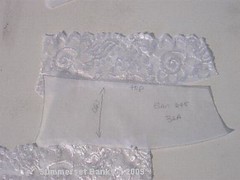
Flip the lace piece over to cut out the other side. Use the scalloped edge of the already cut edge to locate a repeat so that you get a mirror image.
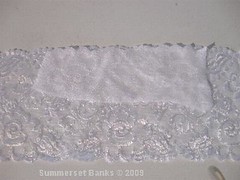 If you have a double scalloped lace, like I'm using for the sample, sometimes the opposite edge has a better mirror image.
If you have a double scalloped lace, like I'm using for the sample, sometimes the opposite edge has a better mirror image. Once cut and placed side by side, you can see that the lace motifs form a mirror image starting at the center.
Once cut and placed side by side, you can see that the lace motifs form a mirror image starting at the center.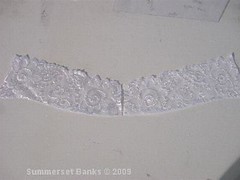
The next installment will be on Thursday, starting with a few words about machine set up and then getting to make the cups!

Hi Summerset - what if we are a bit unsure of our size? Should a mock-up be done first - and if so, from what fabric?
ReplyDeletePatti
Thank you so much for doing this tutorial! I also am excited to see the colors you will be adding to your etsy shop as well. :-)
ReplyDeleteEl
Hello Summerset - I am (finally) getting ready to begin my first bra - and have one other question after re-reading all your instructions -
ReplyDeleteYou said:
"I cut two of the back band in either powernet or tricot and two of the bridge in tricot."
How do you decide which of these to use for the back band?
Patti